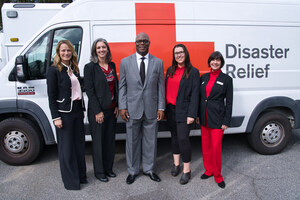WASHINGTON, June 11, 2018 /PRNewswire-USNewswire/ -- Today, the American Red Cross launches the Missing Types campaign, an international effort to encourage new blood donors, as well as donors who have not given in years, to give blood and to help ensure lifesaving blood products are available for patients in need.
As part of the campaign, the letters A, B, and O – letters used to identify blood types – are disappearing across the country and around the world from corporate logos, favorite brands and frequently visited websites. Many may not realize just how important these three letters can be until they are gone.
"Everyday thousands of patients across the United States rely on generous blood donors for critical blood transfusions," said Gail McGovern, president and CEO of the Red Cross. "However, we have seen a troubling decline in the number of new blood donors. We urge the public to roll up a sleeve and fill the missing types before these lifesaving letters go missing from hospital shelves."
In fact, for the past four years, new Red Cross donors have declined by about 80,000 each year. The blood donor base is shrinking. This is not just a Red Cross trend, but a challenge blood collection organizations face across the country and around the world – which is why many are rallying behind this campaign today. Missing Types highlights just how important A's, B's, and O's are – After all there is no _meric_n Red Cr_ss without the A's and O.
Join the #MissingType movement—make an appointment to give blood by visiting redcrossblood.org, using the Red Cross Blood Donor App or calling 1-800-REDCROSS (1-800-733-2767). All blood types are needed.
Survey shows public misconceptions about blood needs
A recent survey, conducted on behalf of the Red Cross, revealed a troubling disconnect between the public's perception of blood donations and the realities of patient transfusion needs.
- Three-quarters (74 percent) of the public underestimate how frequently blood transfusions occur.* Most people perceive blood is needed in the U.S. every 15 minutes or even every hour or two hours when in fact, every two seconds, someone in this country needs blood.
- Nearly half of the public (45 percent) know someone who has been helped by a blood transfusion.* Yet only three percent of the U.S. population donates each year.
- More than one-third (35 percent) of the public has never considered that blood may not be available when they or a loved one need it.* Blood shortages are not uncommon in the United States and can only be prevented when more people roll up a sleeve to give.
- More than half (53 percent) of the public believe they need to know their blood type to donate.* Good news – Potential blood donors do not need to know their blood type before giving blood. After individuals give blood, the Red Cross provides each donor their blood type. Join the movement and find out your blood type this summer.
A missing letter can change everything for a patient
Tymia McCullough, of Georgetown, S.C. is a spirited 12-year-old who aspires to be a pediatrician and model when she grows up. She is also battling sickle cell disease, an inherited disease that causes red blood cells to form an abnormal crescent shape. Sickle cell disease patients can suffer a range of conditions, including acute anemia, tissue and organ damage, terrible pain and even strokes.
With no widely used cure, regular blood transfusions are one of the most common treatments for sickle cell disease. Last year, when McCullough arrived at the hospital, the blood type she needed for her transfusion was not available.
"It was the scariest, most frightening moment of a mother's life, because I thought that she would not be able to get it," said Susie Pitts, Tymia's mother. "In that moment, in that experience, I was very afraid. I was scared for my daughter's life—what was going to happen if she didn't get the blood she needed?"
Eight hours later, the nurse came running through the door with the needed blood product.
Partners join the movement to raise visibility
The Red Cross appreciates the support of its lead partners who have joined the Missing Types campaign, including: Adobe, Anheuser-Busch, AvalonBay Communities, Inc., Domino's, Dropbox, Google, IBM, Land O'Lakes, Inc., Mastercard, Nationwide, Neiman Marcus, the New York Yankees, Oreo, PayPal, Salesforce, State Farm®, Sunoco and U.S. Bank.
Each day, blood and platelets are needed for accident and burn victims, heart surgery and organ transplant patients, and those receiving treatment for leukemia, cancer or sickle cell disease. We are grateful for our partner support to raise visibility for this ongoing need.
Blood donation information
All blood types are needed to ensure a reliable supply for patients. A blood donor card or driver's license or two other forms of identification are required at check-in. Individuals who are 17 years of age in most states (16 with parental consent where allowed by state law), weigh at least 110 pounds and are in generally good health may be eligible to donate blood. High school students and other donors 18 years of age and younger also have to meet certain height and weight requirements.
Blood and platelet donors can save time at their next donation by using RapidPass® to complete their pre-donation reading and health history questionnaire online, on the day of their donation, before arriving at the blood drive. To get started, follow the instructions at RedCrossBlood.org/RapidPass or use the Red Cross Blood Donor App.
Supplemental Information about Survey Methodology
*These are the findings from an Ipsos poll conducted April 16 - 18, 2018 on behalf of the Red Cross. For the survey, a sample of 503 adults ages 18 and over from the continental U.S., Alaska and Hawaii was interviewed online, in English. The precision of Ipsos online polls is measured using a credibility interval. In this case, the poll has a credibility interval of ±5.0 percentage points for all respondents surveyed.
About the American Red Cross:
The American Red Cross shelters, feeds and provides emotional support to victims of disasters; supplies about 40 percent of the nation's blood; teaches skills that save lives; provides international humanitarian aid; and supports military members and their families. The Red Cross is a not-for-profit organization that depends on volunteers and the generosity of the American public to perform its mission. For more information, please visit redcross.org or cruzrojaamericana.org, or visit us on Twitter at @RedCross.
SOURCE American Red Cross
Related Links
WANT YOUR COMPANY'S NEWS FEATURED ON PRNEWSWIRE.COM?
Newsrooms &
Influencers
Digital Media
Outlets
Journalists
Opted In







Share this article